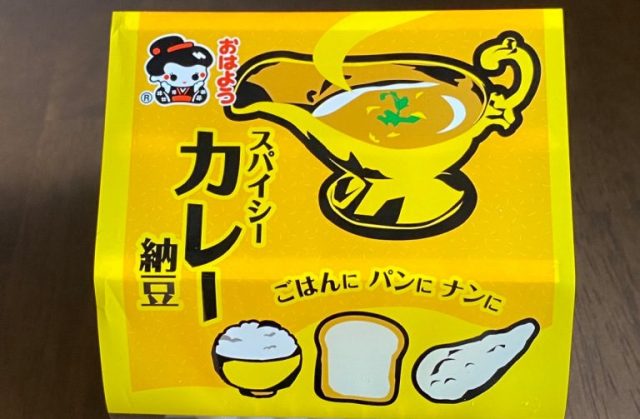
How will the power of curry fare against one of Japan’s most notorious dishes?
Do you like natto? Natto is the Japanese term for fermented soybeans, and though it’s rather popular in Japan and is well-regarded as a health food, it’s notoriously unpleasant to most palates that are unfamiliar with it.
Our Japanese-language reporter Saya Togashi, who is very familiar with natto, found a bright yellow packet of natto while grocery shopping that alleged to be curry powder-flavored. She paid the 95 yen (US$0.87) asking price and took it home to experience it for our benefit.
▼ “Spicy curry natto—have it on rice, bread or naan!” exclaims the bright packaging.
Looking more closely at the packaging, Saya saw that the curry powder in question contained a plentiful blend of spices: turmeric, cilantro, cumin, fenugreek, black and red pepper, and dried citrus peel. In total, more than thirty spices combine to create this flavorful product. Opening the packet revealed two sachets: one of the typical dashi stock served with natto, the other a mix of “special powder”.
▼ Sounds trustworthy.
She set up her plastic container of fermented soybeans and tore open the sachet of special powder. The rich aroma of curry immediately filled the room. Spicy, tantalizing, and a world away from the astringent flavor of natto. Previous curry natto products appear to have used curry paste as their base, but this? This was raw spice.
So impressed was Saya with the powder that she ignored the package’s directions to mix it into a sauce before adding it to the natto.
▼ Direct spice hit!
She mixed all of the special curry powder into the mass of soybeans and reveled as it became sticky, stringy, and glutinous, as natto is want to do. Having activated all those nattokinase enzymes, the place began to smell less like curry and more like natto.
▼ Mix it up well…
▼ Now it’s as sticky and stringy as natto should be.
To be honest, Saya herself is not much of a fan of sticky natto. Even when she adds a sauce or green onions to her natto, she doesn’t mix it very much lest it gets too sticky. But clearly, the intent of this product is to ensure customers mix it well and introduce lots of glutinous strings.
Time to try a bite.
Though the natto overwhelmed Saya’s mouth with spices, it wasn’t spicy at all. It was lacking the painful heat associated with curry…and it was also lacking in terms of sheer curry presence. The natto itself was clearly the star of the show here, with the spectrum of spices only serving to accentuate its raw, fermented might.
It was so intensely natto-esque, in fact, that Saya had to turn to the aid of the dashi stock to stand a chance of finishing it. It too had a gentle curry flavor; she described it as tasting somewhat like curry soba noodles. The added moisture made it much easier to mix.
▼ Yummy.
So how does it taste when the dashi broth is included?
The mellow broth actually subdued some of the natto’s intense natto-tude, and allowed the spice powder to better harmonize with the natural natto flavor. Mellow notes of bonito and kelp made themselves known at first before the curry flavor finally sank in. Saya marveled at how layered the taste was.
So in the end, the curry spice flavored natto tasted much more like natto than like curry spice. This makes it less appetizing to natto newcomers, but more experienced soybean savants will be able to appreciate the depth and quality of the flavor thanks to the added element of the curry spices.
A kimchi-flavored natto product seems to be in the works, so maybe this is the dawn of a brand new era of flavored natto. Personally? We’re waiting on tenterhooks for an orange juice flavored version.
Images © SoraNews24
[ Read in Japanese ]